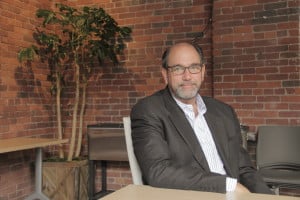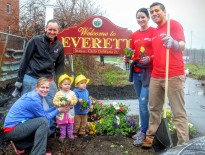Fred Bertino
Title: Co-Founder, President, MMB
Age: 58
Experience: 30 years
From the outset, Fred Bertino’s destiny would have seemed to be in the medical world. After all, his whole family works in that field. But during college, he changed course. During a yearlong break from his studies, he worked for an advertising agency in New York City and it was then that he was hooked. “I loved the way that marketers are problem-solvers with the tools of communication,” Bertino said. Now the head of his own advertising agency, Bertino uses those tools of communication to help banks (and others) solve their problems.
Q: How did you wind up doing work with the financial services space?
A: We’ve worked with a number of investment managers, and as we were growing, we specialized more in the consumer products area and less so in business-to-business. But I’ve always liked the financial services world. I think it’s an opportunity for marketing. Working on Fidelity, as we did for a number of years, and John Hancock, that was exciting. It was an important part of people’s lives. It’s a little bit more impressive than a sub or a salad dressing. So I think the importance of it, I personally like.
It does require a little bit of a different skill set from a marketing and advertising standpoint. People have to be adults and understand the business, understand the language. You have to have the right people working on it. They’re maybe a little bit older, maybe a little bit more savvy financially. Now we’ve put together a little financial services practice here. We’ve done some more project-oriented things for some bigger clients, but we’re looking to figure out who’s the right partner for an agency of record. We have a lot of people we’re talking to right now. It’s kind of overwhelming.
Q: From your point of view, how can community banks differentiate themselves in their marketing from both the big banks and other community banks?
A: I think overall, the community banks are in a pretty good place. I think people are realizing there is an alternative to bigger banks. I think for most people, they ended up with the bank they have, they didn’t necessarily choose it. Now they’re realizing [their] community bank has all the services that the big banks have, which wasn’t maybe the case five or 10 years ago. I think they’ve gradually come up to speed on that.
I think that alternative has really gotten into the cultural conversation, the whole localness of it. And I think some of the banks are embracing some interesting parts of what that means for them. Now how do you differentiate among other community banks?
I saw something a while ago that I thought was really smart. I forget which bank it was, but they offered a product that everybody else offered – I think it was a CD – but they changed the time period of it. So it wasn’t a three-year or a one-year. It was a 15-month. They repackaged what they sell, so it let you think that this bank was a little different, that they’re thinking about things a little bit differently and they’re looking at things from a consumer’s point of view. There is a different sort of approach to it and I think what you took away from it as a consumer was, “I’m going to get this three-year rate for 15 months,” so it was a very smart way to make your product reflect what your brand stands for.
I also think it gets down to the voice of the brand. What’s the voice of this community bank versus another community bank? It’s interesting what some of the community banks do. Some of them are more straightforward and flat, and some of them really do have more of a personality. And I think the ones that do have a personality stand out a little bit.
Q: Where do you see banks go wrong in their advertising and messaging?
A: Again, it’s just answering one question of “What are you buying?” and forgetting “What are you buying into?” It’s forgetting the personality of your bank or your overall brand and getting caught up in things like, “your checking account or my checking account” or “your CD or my CD.” That’s a waste of money.
Q: What are your thoughts around the proliferation of media channels and what that’s meant for your work?
A: We say it’s not about digital marketing; it’s about marketing in a digital world. And I think some people, especially in banking or anybody who has a base audience that’s a little older, they say, “We have to go digital.” Well, what isn’t digital today? Everything is. It’s not about the tools; it’s what you do with them. I call it the Top Chef phenomenon. Now everybody has everything. You have your bowl of ingredients, and how is your cake going to be better than their cake? It’s all in the recipe and how you apply those tools to what your specific problem is.
So mobile and video, those are two areas that I think people who run marketing for any brands, whether it’s financial services or banking, have to be thinking about – what’s the specific recipe for my problem?
For more from Fred Bertino, check out his video interview with Laura Alix.
Bertino’s Top Five Golf Courses:
- Pine Valley Golf Club, Pennsylvania
- Brookline Country Club
- Winged Foot Golf Club, Mamaroneck, New York
- The Olympic Club, Monterey, California
- The Course at Yale, New Haven, Connecticut




 |
| 



